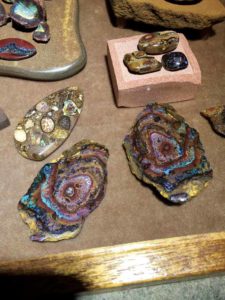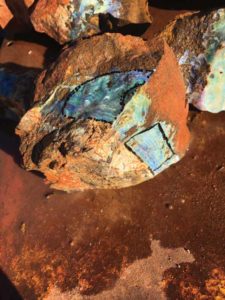
Opal country
Opals are found throughout Australia, with different regions producing different types. We had the chance to visit several distinct areas during our trip.
Lightning Ridge
Lightning Ridge is a town located 743 km (461 mi) southwest of Brisbane, Australia. Its economy is mainly based on mining, opal sales, and tourism. Indeed, many Australian tourists visit this region during winter. There, boundary rider Jack Murray found the first black opals in the year 1900.
Lightning Ridge opals are found at a depth of about 6 to 18 m (19 to 59 ft), often very close to the contact zone between the sandstone on the Earth’s surface and the clay below it. Each miner there is entitled to two concessions of 50 x 50 m (164 x 164 ft), which can be renewed each year.
Once the miner has found a location, he or she has 28 days to study the ground before leasing the concession. The miner analyzes the soil by digging samples up to 10 m (33 ft) deep. Once the concession is finalized, he or she digs a hole about 20 to 30 m (65 to 98 ft) deep by about 1.5 m (5 ft) in diameter. The miner carries down equipment as the hole gets bigger and typically installs vertical pine trunks to solidify the mine.
Crushed rocks are vacuumed up to the surface through a large tube, then loaded directly into a truck. At the end of the day, the miner unloads the truck in what is called an agitator (an old mixer truck or cement mixer). The rocks rotate slowly for two to five days in water, which dissolves clay and sandstone. When the process is finished, only common and precious opals remain.
Yowah
A town of 50 permanent residents located about 1000 km (621 mi) from Brisbane, Yowah is where one can find the ‘Yowah nuts.’ These are opals found in ironstone ‘nuts’ the size of a small avocado.
When the ironstones are sawed in two, opals are discovered either in their centres or in the form of veins. Their formation was a mystery until geologists discovered these rocks once used to be more porous, thus allowing silica-laden water to enter.

On our visit to Yowah, we had the pleasure of meeting opal artist Eddie Maguire, who was kind enough to show us a great part of his collection. Most of the time, the gems in his art are simply sawn in half to show their exceptional beauty and placed on a custom carved wooden base.
Like boulder opals, Yowah opals are rarely completely extracted from the source rock. In these ‘nuts,’ matrix opals can also be found.
Quilpie
One of the most significant parts of our trip was visiting a mine belonging to opal producer Eric Stelzer, located about two hours from the town of Quilpie and accessible only by a bumpy dirt road.
We had the chance to stay at the mine, which produces boulder opals, for two days. This was the first open-sky opal pit we visited, as most of them lay underground. Miners know how deep the opals are, fairly close to old riverbeds.
Just like in Lightning Ridge and Yowah, the soil at this mine is mainly sandstone and clay; one can spot ironstone boulders trapped in the ground. Miners will typically break a few on the spot to see their potential before bringing larger amounts to the camp. Often, they can already notice some veins of colours.
On the second day of our stay at the mine, Eric took advantage of the presence of his son Colin, who is a geologist, to probe another mine about 45 minutes away. With the help of a drone, they were able to take pictures of the topography of the place.
A new perspective
It was amazing to see the full process behind opal mining in Australia. Most miners we met took care of all aspects of mining by themselves, which meant they needed to be very versatile, with the ability to take on different roles. A miner might play the part of mechanic when the truck is broken, engineer when it comes to planning the underground mine and solidifying the walls, businessperson when selling rough or cut opals, and many more.
We also came to realize most miners polish their own rough. They might keep a rough piece for months or even years before they know how it will be cut and which part of the stone will be put in the spotlight.
 Benedicte Lavoie, FGA, is co-owner and vice-president of Pierres de Charme and specializes in fine coloured gemstones. She joined the family business after completing a bachelor’s degree in business and human resources (HR) management and was awarded the internationally recognized title of Fellow of the Gemological Association of Great Britain (FGA–Merit). Based in Montréal, Pierres de Charme supplies fine gemstones to jewellers, goldsmiths, and award-winning artists across Canada and the United States. Benedicte can be reached via e-mail at info@pdcgems.com.
Benedicte Lavoie, FGA, is co-owner and vice-president of Pierres de Charme and specializes in fine coloured gemstones. She joined the family business after completing a bachelor’s degree in business and human resources (HR) management and was awarded the internationally recognized title of Fellow of the Gemological Association of Great Britain (FGA–Merit). Based in Montréal, Pierres de Charme supplies fine gemstones to jewellers, goldsmiths, and award-winning artists across Canada and the United States. Benedicte can be reached via e-mail at info@pdcgems.com.
 Martine Lavoie, FGA, is president of Pierres de Charme, a company specializing in the sale of gems and precious stones. She founded the company in 2012. With more than 30 years of business experience, Martine has been able to contribute her talents as a dynamic entrepreneur with a sound knowledge of gemmology and jewellery appraisal to Pierres de Charme. In 2016, she was appointed the International Colored Gemstone Association’s (ICA’s) ambassador for Canada. Martine can be reached via e-mail at info@pdcgems.com.
Martine Lavoie, FGA, is president of Pierres de Charme, a company specializing in the sale of gems and precious stones. She founded the company in 2012. With more than 30 years of business experience, Martine has been able to contribute her talents as a dynamic entrepreneur with a sound knowledge of gemmology and jewellery appraisal to Pierres de Charme. In 2016, she was appointed the International Colored Gemstone Association’s (ICA’s) ambassador for Canada. Martine can be reached via e-mail at info@pdcgems.com.





